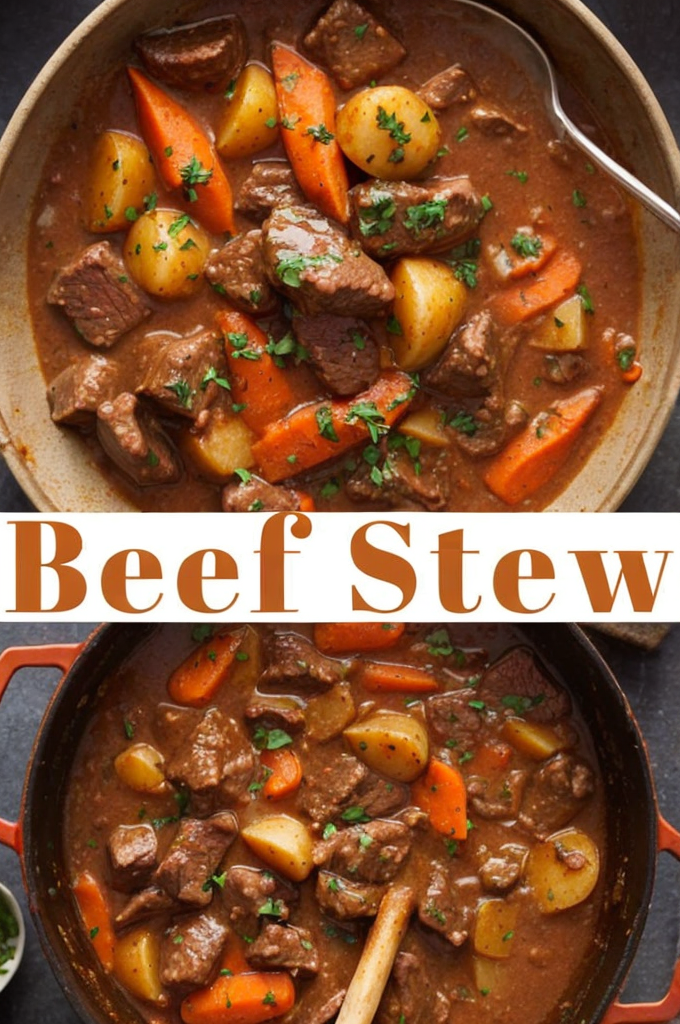Best Beef Stew with Carrots & Potatoes – A Family Favorite
There’s nothing quite like a warming bowl of the best beef stew with carrots & potatoes to comfort you on a chilly evening. As the rich aroma fills your home, you’ll find yourself drawn to the kitchen, eager to taste the tender beef and perfectly cooked vegetables simmering in a savory broth. Known for its heartiness and robust flavors, this beef stew is a beloved family favorite that never fails to impress at the dinner table.
In our home, this recipe is more than just a meal; it’s an experience that brings family together. With a blend of tender chunks of beef, sweet carrots, and soft potatoes, this dish offers a delightful balance of taste and texture. Whether you’re gathering around for a family dinner or meal-prepping for the week, this beef stew hits all the right notes of comfort food.
Quick Recipe Highlights
- Flavor Profile: Savory and rich with a hint of sweetness from the carrots, the beef stew offers a balanced medley of herbs and spices that enhance the natural flavors of the ingredients.
- Texture: The stew boasts tender chunks of beef that melt in your mouth, complemented by soft potatoes and carrots that hold their shape yet provide a creamy contrast.
- Aroma: As the stew simmers, your kitchen fills with the fragrant scent of herbs and spices mingling with the deep, meaty aroma of the beef.
- Visual Appeal: A vibrant dish filled with earthy colors from the carrots and potatoes paired with the rich, dark gravy that glistens in the light.
- Skill Level Needed: This recipe calls for some patience and basic cooking techniques, making it ideal for cooks with moderate experience looking to expand their repertoire.
- Special Equipment: A sturdy Dutch oven or a large pot ensures even cooking and enhances the flavors as the stew simmers to perfection.
Recipe Overview
- Difficulty Level: Considered medium due to the need for careful browning and timing, this recipe helps you develop your cooking skills with rewarding results.
- Category: This warm and hearty stew falls under comfort food and main course categories, often enjoyed during lunch or dinner.
- Cuisine: While rooted in traditional American fare, this beef stew draws influences from various global traditions that all showcase the beauty of slow-cooked meats.
- Cost: Generally affordable, this recipe uses cost-effective cuts of beef, plentiful vegetables, and pantry staples, making it suitable for budget-conscious households.
- Season: Most enjoyable in fall and winter when hearty meals are appreciated, though it remains a delicious option year-round.
- Occasion: Perfect for family gatherings, casual dinners, or as a make-ahead meal to warm up busy weeknights.
Why You’ll Love This Recipe
Beef stew is beloved for its deeply satisfying flavor and hearty texture, offering a delightful interplay of taste and aroma in every bite. The tenderness of the beef, perfectly complemented by soft potatoes and sweet carrots, makes each spoonful a comforting experience.
Preparing this stew is a stress-free process, with most of the cooking occurring while you relax. With minimal active time required, you can comfortably leave it to simmer, infusing your home with inviting scents.
This recipe is not only delicious, but it also provides essential nutrients. Packed with protein, fiber from the vegetables, and vitamins, it can be a balanced meal on its own. The ingredients work together to offer a robust nutritional profile that supports your well-being.
The social aspect of beef stew only adds to its charm. As a beloved family dish, it’s ideal for both intimate family dinners and larger gatherings, offering warmth and hospitality with each serving.
Finally, the affordability of the ingredients, coupled with their availability, makes this stew a go-to meal for any day. With ingredients often found in your pantry or freezer, it’s accessible and simple to prepare on short notice.
Historical Background and Cultural Significance
Beef stew boasts a rich history rooted in the necessity of creating nourishing meals that are both economical and satisfying. Originating in rustic kitchens where ingenuity led to blending easily accessible ingredients, this dish embodies the essence of homestyle cooking.
Culturally, beef stew has evolved to reflect regional diversity, with every community adding its unique touch. This adaptability underscores the stew’s universal appeal, mirroring the rich tapestry of global culinary traditions while maintaining its core of warmth and comfort.
Over the years, beef stew has captured hearts across nations, each variant telling the story of its people’s ingredients, tastes, and heritage. Whether it’s Kaffee-roasted beef in a European variant or spiced with local herbs in Asia, the beef stew continues to absorb influences, enhancing both its legacy and flavor.
Regional variations abound, with each iteration showcasing distinct flavors and preparation methods. This culinary classic has matured over centuries, always maintaining its role as a hearty tribute to community and kinship.
Ingredient Deep Dive
Beef:
Beef is the heart of this stew, providing the dish’s rich, savory depth. Selecting the right cut is crucial—look for chuck or brisket, known for their flavorful marbling. Selecting quality beef ensures tenderness after long, slow cooking. Nutritionally, beef offers a high protein content along with essential vitamins like B12 and zinc, crucial for energy and immune support.
Carrots:
Carrots bring natural sweetness and color to the stew, balancing the savory notes. Their vivid orange hue not only enhances presentation but also promises vitamin A for eye health and antioxidants for general wellness. They store well when kept in a cool, dry place, extending their shelf life and convenience in meal planning.
Potatoes:
The potatoes’ mild taste and creamy texture perfectly complement the stew’s robust flavors. Opt for waxy varieties like Yukon Gold that hold their shape during cooking. Potatoes are a good source of potassium and carbohydrates, essential for energy. Store them in a dark, cool environment to maximize freshness.
Common Mistakes to Avoid
- Overcrowding the pot during browning can hinder proper caramelization of the beef, leading to bland flavors.
- Not allowing the stew enough cooking time may result in tough beef and undercooked vegetables.
- Skipping the searing step limits the development of rich flavors in the stew.
- Adding vegetables too early can cause them to become mushy; timing is key for perfect texture.
- Using lean beef cuts can lead to a dry, chewy final product; aim for marbled cuts.
- Neglecting to season properly will leave the stew tasting flat; adjust to taste during cooking.
- Overlooking the use of fresh herbs at the end will diminish the stew’s aromatic appeal.
- Stirring too frequently can break down delicate ingredients, losing the stew’s chunky texture.
Essential Techniques
Mastering the correct searing method is crucial for developing the stew’s savory depth. Achieving a proper golden-brown crust enhances flavor through the Maillard reaction, a chemical reaction between amino acids and reducing sugars that adds umami.
Maintaining a gentle simmer ensures the meat becomes tender without breaking apart. A rapid boil can lead to tough beef, so adjust your heat to maintain a consistent, gentle bubble. Visual cues of a proper simmer include occasional small bubbles and minimal surface activity.
Pro Tips for Perfect Beef Stew with Carrots & Potatoes
Invest time in browning the beef for a deeper, complex flavor profile. Each piece should have a consistent golden-brown crust for maximum flavor integration.
Introduce fresh herbs during the last few minutes of cooking to brighten and elevate the stew’s flavor. This step enhances the dish’s aromatic elements without overwhelming its savory foundation.
When seasoning, taste and adjust in stages. Initial salting should be light, with adjustments made about halfway through cooking to ensure balanced seasoning.
Variations and Adaptations
Each region adapts beef stew to its tastes, utilizing local ingredients. Consider swapping the primary vegetables for regional produce like parsnips or turnips. These elements offer subtle sweetness and earthiness while preserving the stew’s heartwarming qualities.
Seasonal adaptations are limitless. In summer, consider serving the stew with a light, fresh salad to balance the heavier elements. For winter, serve with buttered rolls or mashed potatoes to amplify the comforting warmth.
Serving and Presentation Guide
Enhance your plating with visual contrasts, pairing amber stew with parsley’s bright green. For a rustic presentation, serve directly from the cooking pot, inviting diners to savor the warm and communal feel.
Traditional accompaniments such as crusty bread or fluffy dumplings allow diners to mop up every bit of the stew’s flavorful gravy, enhancing the overall eating experience.
Wine and Beverage Pairing
A robust red wine like Cabernet Sauvignon pairs beautifully with the stew’s deep flavors, matching its richness. For those preferring non-alcoholic options, consider a bold black tea, which offers complementary tannins.
Temperature should be slightly warmer than room temperature for the wine, accentuating its bouquet and flavors when paired with stew, while a slightly cooler non-alcoholic alternative cleanses the palate with its refreshing qualities.
Storage and Shelf Life
Beef stew improves with time, as flavors meld. Store in an airtight container in the refrigerator, where it remains fresh for up to three days.
For an extended shelf life, freeze individual portions, and defrost overnight in the fridge to retain texture. When reheating, a gentle simmer on the stove preserves flavors while refreshing the dish’s warmth.
Make Ahead Strategies
Begin preparation a day in advance, allowing flavors to develop overnight. Complete cooking, then chill in shallow containers for efficient cool-down and storage.
Consider assembling ingredients early, storing chopped vegetables separately in airtight bags. The stew benefits from an overnight rest, with seasoning adjustments made after reheating for perfect taste.
Scaling Instructions
Halving the recipe is seamless: adjust seasoning to taste, halving also allows for quicker cooking. For larger gatherings, doubling requires increased pot size and careful monitoring for even cooking distribution.
Refrigerator space becomes crucial for storing scaled-up portions. Portion into smaller containers to maintain efficiency during storage and access.
Nutritional Deep Dive
The beef stew offers a balanced macronutrient profile, with protein from beef supporting muscle health, carbohydrates from potatoes, and fibers from carrots supporting digestion.
Rich in vitamins and minerals like B vitamins, which aid in energy metabolism, and potassium for fluid balance, the stew nurtures each aspect of your diet while maintaining its hearty appeal.
Dietary Adaptations
Gluten-free: Swap out flour thickener with cornstarch slurry or arrowroot powder, ensuring a smooth, glossy consistency without gluten content.
Dairy-free: Since the recipe is naturally dairy-free, no adjustments are needed beyond perhaps avoiding serving with cheese-laden accompaniments.
Vegan: Replace beef with tender chunks of seitan or jackfruit, infusing vegetable stock with extra richness for a complete vegan adaptation.
The Recipe
Best Beef Stew with Carrots & Potatoes
Serves: 6
Prep Time: 30 mins
Cook Time: 90 mins
Total Time: 120 mins
Kitchen Equipment Needed
- Large Dutch oven or heavy pot
- Wooden spoon
- Ladle
- Chef’s knife
- Cutting board
Ingredients
- 2 lbs beef chuck, cut into 1-inch cubes
- 3 tablespoons olive oil
- 4 cups beef broth
- 3 carrots, sliced
- 4 potatoes, cubed
- 1 onion, chopped
- 2 cloves garlic, minced
- 1 tablespoon tomato paste
- 1 teaspoon thyme
- Salt and pepper to taste
- 2 bay leaves
Directions
- In a large pot over medium-high heat, brown the beef cubes in olive oil until well-browned on all sides. Remove and set aside.
- In the same pot, sauté onion and garlic until onion is translucent.
- Stir in the tomato paste, cooking for another minute.
- Return beef to the pot and add broth, potatoes, carrots, thyme, bay leaves, salt, and pepper.
- Bring to a boil, then reduce heat to low and cover. Simmer for 90 minutes, or until beef and vegetables are tender.
- Taste and adjust seasoning before serving hot.
Recipe Notes
- For added depth, deglaze the pot with red wine after browning the beef and before sautéing onions.
- Consider adding peas or mushrooms for extra flavor.
Troubleshooting Guide
If your stew turns out too runny, consider allowing it to simmer uncovered until it reaches your desired consistency.
To balance flavors, adjust salt incrementally, remembering that the addition of fresh herbs or a squeeze of lemon juice can lift the dish’s profile if it seems flat.
Maintaining a gentle heat prevents both scorching and uneven cooking, ensuring a balanced preparation and texture.
Recipe Success Stories
Readers frequently share their experiences, showcasing the adaptability of this beef stew. From adding local ingredients to crafting unique servings, these victories emphasize the dish’s universal appeal.
Photography enthusiasts often highlight how lighting impacts the presentation, with natural light enhancing the stew’s vibrant colors and textures.
Frequently Asked Questions
Q: Can I use a slow cooker for this beef stew?
A: Absolutely! Searing the beef and onions first enhances flavor, then transfer to a slow cooker, adding vegetables and broth to cook on low for 6-8 hours.
Q: What can I do if my stew is too salty?
A: If your stew turns out too salty, try adding a peeled, raw potato to the pot to absorb excess salt during continued cooking. Alternatively, adding unsalted broth or water can dilute the dish.
Q: How do I prevent my vegetables from becoming mushy?
A: To retain texture, add vegetables halfway through cooking, allowing them enough time to cook through without disintegrating.
Q: Is it possible to make the stew the day before?
A: Yes, making the stew a day ahead improves flavor development. Simply store in the fridge and reheat on low, adjusting seasoning where necessary.
Q: Can I freeze beef stew?
A: Yes, beef stew freezes well. Once cooled, portion into airtight containers, ensuring sufficient space for expansion while freezing.
Q: What should I serve with beef stew?
A: Complementary sides include crusty bread, mashed potatoes, or a fresh side salad. These options enhance the stews based on communal dining traditions.
Q: How can I thicken my beef stew if needed?
A: Thicken your stew by creating a slurry with cornstarch and cold water, stirring it back into the pot, ensuring it cooks to remove any starchy taste.
Q: Will the beef stew taste better if I use fresh herbs?
A: Fresh herbs indeed add a more pronounced aromatic profile, elevating the stew’s overall flavor complexity and freshness.
Q: Should I peel the potatoes for beef stew?
A: It’s a matter of preference. Leaving the skins on adds texture and nutrients, whereas peeling offers a smooth, consistent finish.
Q: Is beef stew a complete meal?
A: With sufficient protein, carbs, and veggies, beef stew can serve as a well-rounded meal, though additions like bread can enhance its heartiness.
Additional Resources
For those interested in improving their beef stew techniques further, explore related recipes that celebrate beef in various cuisines or delve into guides detailing beef cuts and their best applications.
Explore resources that highlight complementary techniques, such as perfecting the art of gravy-making, to bolster your culinary knowledge and enhance your cooking repertoire.
Join the Conversation
Whether you share your beef stew photos online or swap personal tips, joining the culinary conversation enhances community engagement. Social platforms offer direct feedback and inspiration, fostering recipe evolution.
By reviewing this recipe, sharing variations, or suggesting improvements, you contribute to the culinary community, enriching everyone’s experience in making and enjoying this beloved beef stew.



